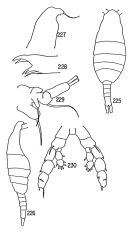
issued from : G.D. Grice & K. Huisemann
in Proc. U.S. natn. Mus., 1967, 122 (3583). [p.61, Figs.225-230].
Male (from 05°53'S, 79°57'E): 225, habitus (dorsal); 226, idem (lateral right side); 227, forehead (lateral); 228, Md (cutting edge); 229, Mx1; 230, P5.
Nota: Head and 1st thoracic segment separate, 4th and 5th fused.Anal segment very long, longer than furca. Large rostrum rounded with rostral filaments slender. Right A1 reaching anal segment, left geniculate. Exopod of A2 8-segmented, small, extending to 2/3 of 1st segment of endopod.Mx1 much reduced. Number of setae on lobes 1-6 of Mx2: 1 and a small process, 1 (?), 2, 2, 2, 1 respectively. Number of setae on first 5 lobes of Mxp: 1, 1, 2, 2, 2, respectively. Exopods and endopods of P1 to P5 3-segmented. Seta on 2nd basipodal segment of P5 short; Inner margin of 2nd exopodal segment of right P5 with process near proximal corner; external spines of 1st and 2nd exopodal segments with a small knoblike protusions apically near their base.
The structure of Md and Mx1 as well as the relatively long genital segment suggest a close relationship to
E. affinis Sars. The one male specimen found differs from Sars' description (1924-25) of the female in a reduced number of spines or setae, respectively, on the 1st inner lobe and the outer lobe of Mx1, Mx2 and Mxp.




